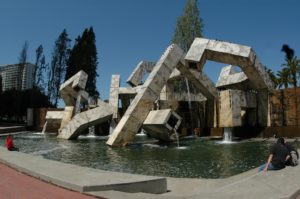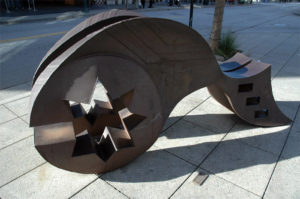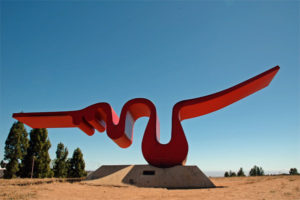Usually I design Burning Man projects to last for the week. This choice means that wood and metal remain unpainted and that nothing is supposed to get very wet. Then if I want to save a project and return it to the playa in a future year, I need to store it out of the weather, and that takes space that I don’t have.
Looking at public art around town, I realized that one can construct pieces that last for decades. Here’s is Harold Moodie’s Untitled Clevis #2 (image from localwiki.org). It’s been downtown for 23 years, rained on every winter, and surviving unharmed—and apparently unmaintained.
Kenny Farrell’s piece Untitled at UCSC is looking good after 42 years outdoors. (Image from localwiki.org.)
And just last week when attending a conference in San Francsico, I spied the Vaillancourt Fountain across the street in Justin Herman Plaza. (Image from Wikipedia.) I hadn’t see this piece in decades, and it seems to be surviving the San Francisco weather without problems.

Vaillancourt Fountain, Armand Vaillancourt, 1971
So with proper materials and construction, I can make art that will last outdoors like these pieces. What kinds of materials and construction are required? Harold Moodie’s unpainted steel piece is constructed from COR-TEN steel, which is a special alloy that survives outdoors unpainted. Kenny Farrell’s piece receives periodic repainting (probably because it uses a more normal steel alloy). And Vaillancourt’s piece is constructed from precast concrete, an ordinary building material. What should I use?
While using COR-TEN steel is tempting, this material seems to be available only in sheet form, and one must use special welding techniques to prevent the welds from corroding. Rather than complicating construction, I’ll just use ordinary steel and paint it. So which paint?
- SprayMax 2K two-part epoxy paints are used by folks who build custom cars. Car paint usually survives outdoors for decades.
- SprayMax 2K two-part clear coats also are available.
So the exterior steel parts can be painted. What about the other parts of the project?
- Glass windows of cars and houses last. I’ll use glass for the windows of Miles.
- EPDM rubber seals are used by the automotive industry. McMaster-Carr has EPDM rubber glass seals just for this purpose. In addition, since the piece will be assembled on-site from several subassemblies, I’ll need to provide seals between the subassemblies to avoid rainwater leaks. McMaster-Carr also has EPDM rubber sheets and EPDM rubber washers.
- 3M CA40 adhesive will glue pieces of EPDM rubber together to make gaskets of any needed shape.
- Marine grade high-density polyethelene (HDPE) is dimensionally stable, slippery, and UV resistant. To reduce wear and friction, the interior 140-tooth gear will be constructed from this material.
- Teflon (PTFE) also is UV resistant. While it is not dimensionally stable, in sheet form it can be used to make low-friction gear spacers.
- Zinc-aluminum-coated screws, nuts, and washers are better than ordinary grade 8 fasteners, which I’ve seen corrode when exposed to the playa repeatedly. Since I don’t want to paint the hold-down nuts and bolts, I’ll use this material for these four fasteners. I’d use stainless steel fasteners, which are more common, but they may gall, which prevents their subsequent removal. So zinc-aluminum coating looks like the way to go.
Using these materials should let me show the piece outdoors for years.

